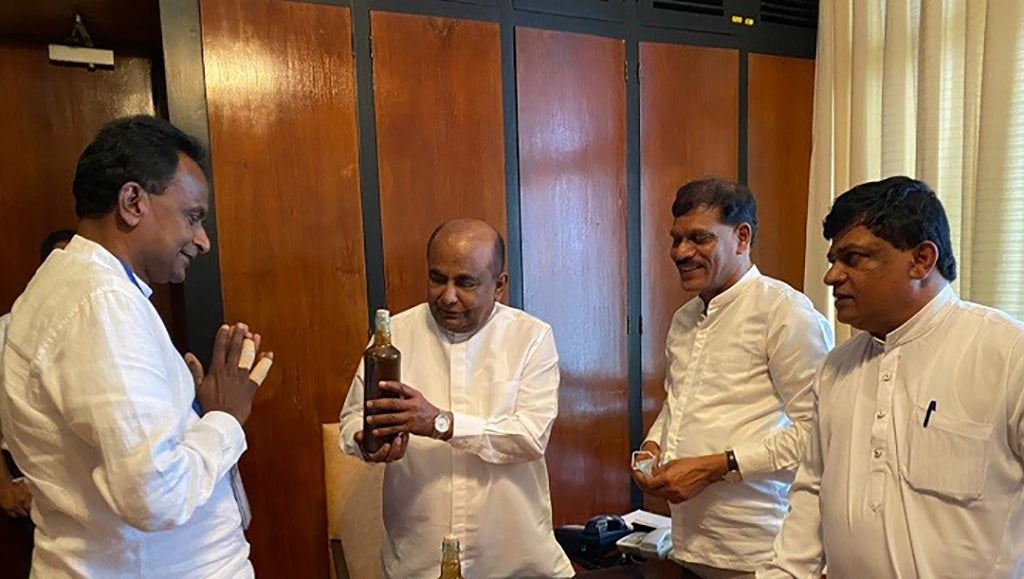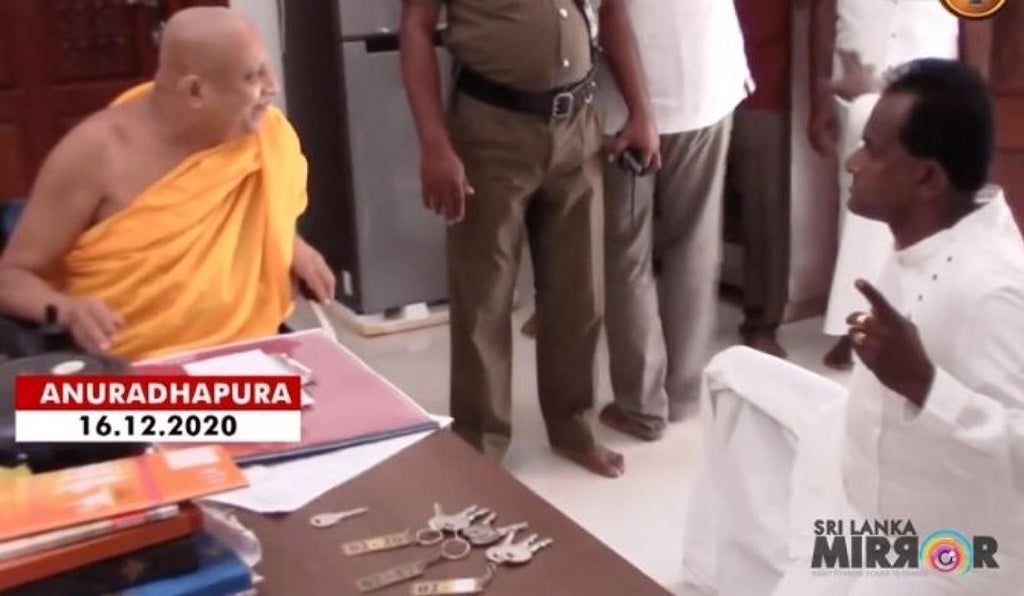Miracle cure for COVID-19 in Sri Lanka: Kali and the politics behind ‘Dhammika Paniya’
contributed by Catherine West & Kanchana Dodan Godage, 3 March 2021

Figure. 1. Kali takes many forms including Bhadrakali, pictured here at a temple near Kandy, Sri Lanka. Photograph by Yaathavan Arul, February 2021
After months of curfews, lockdowns, and low infection rates, Sri Lanka’s COVID-19 case numbers spiked in October and November 2020. In early December, news emerged about a tonic called ‘Dhammika Paniya’ that had the power to prevent and heal the disease. Initially promoted as an Ayurvedic medicine, its inventor later attributed its strength to the goddess Kali.
This appeal to the transcendent is not an alternative to biomedicine or Ayurveda, but one that is imbricated in the everyday political and social response to the pandemic crisis in Sri Lanka. In the dramatic rise of Dhammika Paniya, we can observe a mosaic of perceptions, anxieties, and hopes that exist in tension with the nation’s well-developed public health system. This article follows the government’s involvement in the Dhammika Paniya story primarily by analysing mass media coverage over the past few months, supplemented with interviews and personal observations.
Miracle cure?
On the 3rd of December 2020 The Daily Mirror’s headline ‘Miracle cure for COVID-19?’ was one of the first to raise the hopes of the increasingly worried Sri Lankan public. Dhammika Paniya may have quietly gone the way of other ‘miracles’, except that the Minister for Health, Pavithra Wanniarachchi (and some of her colleagues) consumed a spoonful of the medicine, and photographs were widely distributed in the media. The name of the syrup comes from its main ingredient, honey (paniya in Sinhala) and its creator, a Sinhalese businessman, Dhammika Bandara.

Figure. 2. Dhammika Bandara presenting a bottle of ‘Dhammika Paniya’ to speaker Mahinda Yapa Abeywardene (Credit: EconomyNext, 20th January 2021)
Large crowds
Following these news reports, over 10,000 people converged at Bandara’s home in rural Hettimulla (about 100 km north east of the capital Colombo). The crowds posed problems for the local authorities who struggled to enforce social distancing rules. Initially, public order was the main issue. However, accusations of fraud emerged, along with claims that Bandara was not trained in Ayurvedic medicine. The State Minister for Promotion of Indigenous Medicine, Sisira Jayakody, endorsed the tonic, whereas the State Health Minister, Sudarshini Fernandopulle, warned that it first needed to be tested and approved. President of the College of Medical Laboratory Science, Ravi Kumudesh told The Island newspaper: “We have confused people and they are now clutching at straws.”
Dhammika Bandara gets loud
What Bandara did next is reminiscent of what many Sri Lankan politicians do when faced with trying circumstances. He visited the nation’s most famous Buddhist temples: Sri Dalada Maligawa in Kandy and the Jaya Sri Maha Bodhi in Anuradhapura. In a personal communication with a Hettimulla resident, the authors learnt that Bandara had campaigned to represent the SLPP (Sri Lanka Podujana Peramuna, the ruling national political party) in the 2018 local government elections. Although unsuccessful, Bandara plans to try again, and our informant felt that the fame of Dhammika Paniya may well give Bandara an advantage in joining the ranks of the political elite.
Positive media coverage of Bandara’s pilgrimage to the temple at Anuradhapura was derailed when he was refused access to the carefully guarded upper terrace (where the original bodhi tree is said to have been planted in the 3rd century BCE) and was instead directed to the adjacent bodhi trees that are accessible to the public.

Figure. 3. Dhammika Bandara ‘gets loud’ with the Most Venerable Pallegama Sirinivasa Thero at the Jaya Sri Maha Bodhi in Anuradhapura (Credit: Sri Lanka Mirror, 17th December 2020)
Video footage of Bandara berating the Chief Incumbent at Anuradhapura, shouting ‘I am Kali. I am your mother’ - an act most Sri Lankans would consider extremely rude - indicates the extent to which this event undermined Bandara's desired authority. However, it also brought new energy to the reputation of the treatment: audacious, uncontrolled, and demonic, a little like the coronavirus itself. Bandara explained that Kali gave him the recipe for the tonic in a dream; that it derives its healing power from the goddess, and that he was possessed at the time the video was taken. Nevertheless, thousands continued to flock to his property at Hettimulla, which has a bo tree and a Buddhist shrine, but is also the site of the Sri Weera Maha Bhadrakali Devalaya, a temple to Kali in one of her most fierce forms. News reports eventually confirmed that Bandara is not an Ayurvedic doctor, but rather a maniyo (a spirit medium).

Figure. 4. This Sri Lankan statue of Bhadrakali shows her direct intervention in the worldly affairs of humans. Behind the main image we see a painting of Bhadrakali, in blue, depicted in a style seen more commonly in India. Photograph by Yaathavan Arul, February 2021
The Buddha, Kali, power, and merit
Calls for Bandara to cease using Kali’s name in relation to his product, made publicly by a swami from a famous Hindu Kali temple, echo the widely accepted notion that one should invoke Kali only with great courtesy and caution. In multireligious Sri Lanka, Kali is not only a Hindu goddess, but also part of the Sinhala Buddhist pantheon in which she is associated with another goddess, Pattini. She has many instantiations (including Bhadrakali) and a long association with traders and businesspeople, like Bandara.
In accordance with Sinhala Buddhist beliefs, Bandara recognises that the Buddha does not intervene in worldly affairs but Bhadrakali can accept the pleas of humans and channel her wild destructive power against the coronavirus to accumulate merit. About 70% of the Sri Lankan population are Buddhist, 99% of the population profess to follow one of the four main religions, and many Sri Lankans have plural religious practices. While Buddhists and Hindus might have a direct association with Kali, she is also familiar to Christians and Muslims in Sri Lanka. Recognition of her power exists within the mainstream population. Of course, all four religious groups contain sceptics, and many Sinhala Buddhists see spirit worship as un-Buddhist, but this can be skin deep, particularly at times of crisis.
Populism and pragmatism
Sajith Premadasa, the opposition leader, and many other political figures accused the government of using the notoriety of Dhammika Paniya to conceal their inadequate response to the pandemic. Indeed, the efficacy of the treatment was being taken seriously by the Pharmacology section of the Ayurvedic Department. National Research Council Chairman Prof. Hemantha Dodampahala said that: ‘The Council is yet to receive the proposal by Mr. Dhammika Bandara and will take immediate action when the proposal is received, to facilitate the trial in (an) advisory and monetary capacity’. One journalist speculated about who would be held responsible if the treatment caused problems: the government, Kali, or Dhammika Bandara?
In this flippant musing, there lies a larger point. The nationalism of the Sinhala Buddhist government (and its main opposition) rides on a rhetoric which shuns the modern, secular, urban lifestyle, and reifies an idyllic pre-European-colonial village society. The success of Dhammika Paniya is based in notions of indigenous superiority (local Ayurveda versus Western biomedicine) and the recognition that many Sri Lankans of various ethno-religious backgrounds use multiple methods (natural, supernatural and pharmacological, mediated through social networks) in sequence, or simultaneously, to address health issues. The government’s reticence to reject Dhammika Paniya outright is founded in nationalist populism and political pragmatism.
Secondary elaboration and diversionary tactics
Dhammika Paniya continued to make the headlines in January 2021, including opinion pieces from medical professionals, reports of its availability (then withdrawal) from Ebay, and speculation about its official approval as a ‘food supplement’. Bandara gave an interview where he affirmed that Kali should receive credit for the medicine, and that people in the armed forces and state institutions who had taken it were now ‘very healthy’. He claimed that the results of scientific experiments conducted at University of Sri Jayewardenepura would be released when the government’s trials were complete. In response to his critics, he warned: ‘We have a government in our country. We have a law. Obtain an order from (the) courts and stop insulting me.’
On the 23rd of January, the Minister of Health, whose consumption of the tonic fuelled its meteoric rise, announced that she had contracted COVID-19. Bandara claimed that she had taken an incorrect dose and that he could still cure her. Many more politicians became infected and derisive commentary escalated, with individual parliamentarians describing the cure as sorcery and black magic. By early February, Dhammika Paniya was eclipsed by news of the government’s vaccination program, and controversy over the forced cremation of Muslims who had died of COVID-19 (a policy that was later reversed).
The government’s prescription: Ayurveda, allopathy, and Kali
In conclusion, Dhammika Paniya lays bare some unspoken elements of the political process in Sri Lanka. The spiritual, economic, and political actions of Bandara are consistent with existing patterns of client/patron relations, despite the extraordinary circumstances. Alongside the rise of this ‘miracle cure’, we see the government combining Western medicine, Ayurveda, and an ambivalent acceptance of spiritual solutions to assuage the public’s fears and the spread of the coronavirus. This approach corresponds well to the heterogeneous, associational health beliefs and practices of the people. The government’s pandemic response has also traded on nationalist pride by tacitly supporting an unproven indigenous medicine, amplified by the awe surrounding Kali’s supernatural ability to protect.
Disclaimer: The views and opinions expressed in this article are those of the authors and do not necessarily reflect the position of the blog editorial team or the Asia Research Institute.
South Asia | Southeast Asia | East Asia | Other Places | Hinduism | Buddhism | Islam | Christianity | Other Religions
Catherine West is an anthropologist who is currently completing her PhD at Deakin University, Australia. She is writing about the post-independence transformation of Colombo, Sri Lanka, in terms of the urban environment, social formation and religion. You can find more of her work on her Academia profile.
Kanchana Dodan Godage is a political scientist currently teaching at the Open University Sri Lanka, Nawala, Colombo. She is interested in the electoral process, levels of government, and the broad social context of politics.

